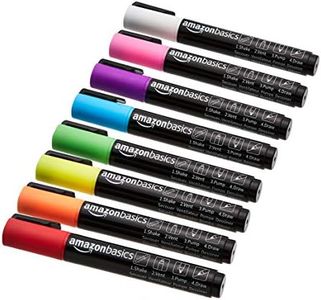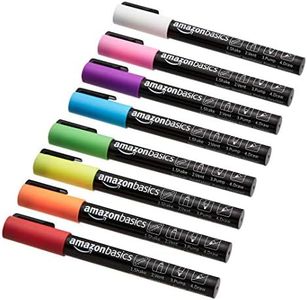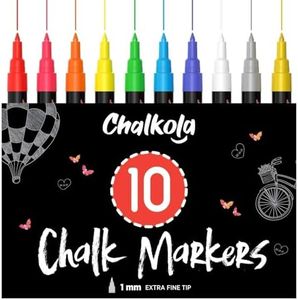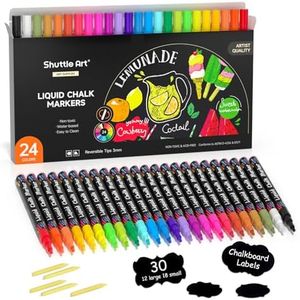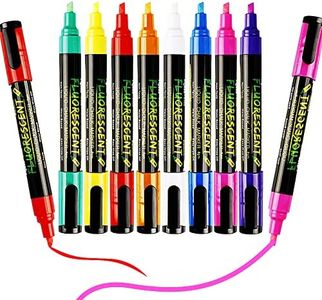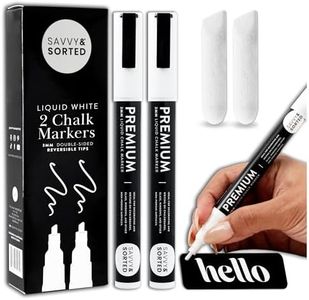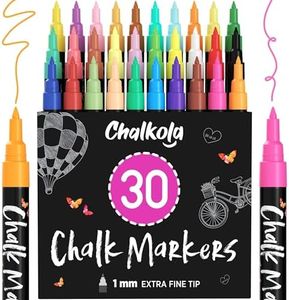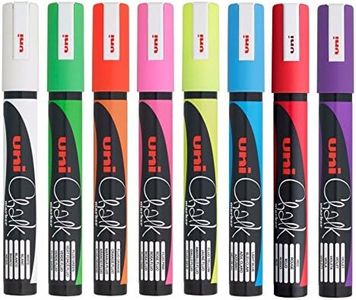We Use CookiesWe use cookies to enhance the security, performance,
functionality and for analytical and promotional activities. By continuing to browse this site you
are agreeing to our privacy policy
10 Best Chalk Markers
From leading brands and best sellers available on the web.Buying Guide for the Best Chalk Markers
Choosing the right chalk markers can make your writing, drawing, or decorating projects much more enjoyable and effective. There are a few important features to consider to make sure the markers suit your particular purpose, whether you’re labeling jars, making menu boards, or creating artwork on non-porous surfaces. By understanding the main specifications and how they connect to your needs, you’ll confidently find a set that works best for you.Tip Size and ShapeThe tip size and shape of chalk markers are essential because they decide how thick or thin your lines will be. Tips come in several types like fine, bullet, and chisel, each suitable for different tasks. Fine tips are great for detail work, small labels, or writing in tight spaces. Bullet tips give a rounded, consistent line, ideal for general writing. Chisel tips let you draw both thin and thick lines, making them versatile for both bold lettering and details. To choose the best tip, consider what you plan to do most—detailed work needs finer tips, while larger surfaces like boards may benefit from chisel or bullet tips.
Ink TypeChalk marker ink is usually either water-based or oil-based, and this impacts how bright it appears, how easy it is to clean, and what surfaces it works on. Water-based ink is most common, offering vibrant colors that wipe off easily from non-porous surfaces like glass or chalkboards. Oil-based markers might be more permanent but can be harder to remove. When choosing, think about whether you want your work to be easily erased or long-lasting, and make sure it fits the surface you plan to write on.
Surface CompatibilityNot all chalk markers work on every surface. The intended surface is important because using markers on the wrong type can lead to stains or poor performance. Most chalk markers are made for non-porous surfaces such as glass, metal, plastic, and certain chalkboards. They might not erase well on porous surfaces like regular paper or untreated wood. Before purchasing, check the marker's label to confirm it matches with what you’ll be decorating or labeling, and if in doubt, always spot test.
Color RangeColor variety matters for both creative and practical uses. Some sets offer just white, while others provide a whole rainbow. If you’re creating art or need to highlight information in different ways, having many colors gives you more flexibility. For basic labeling or writing, a small range (or even just white) might be sufficient. Pick according to how visually expressive or colorful your projects are.
Erase-abilityHow easily the marker can be erased is crucial, particularly if you want to reuse surfaces. Some markers wipe off with just a dry cloth, while others may require a wet wipe or cleaner. Think about how often you plan to change your writing or drawing—if you need to update messages or displays often, easy erase-ability will save you lots of hassle.

